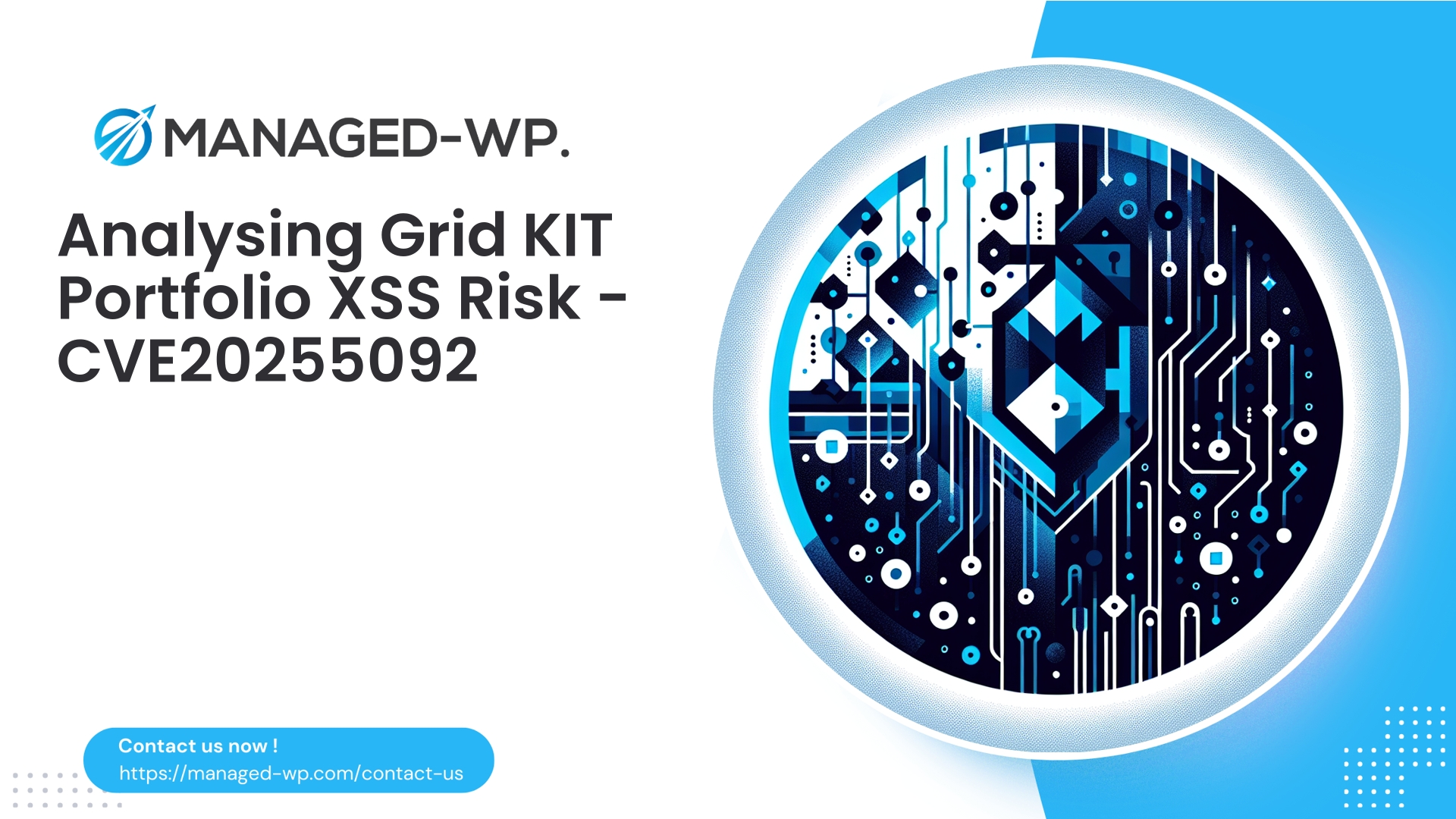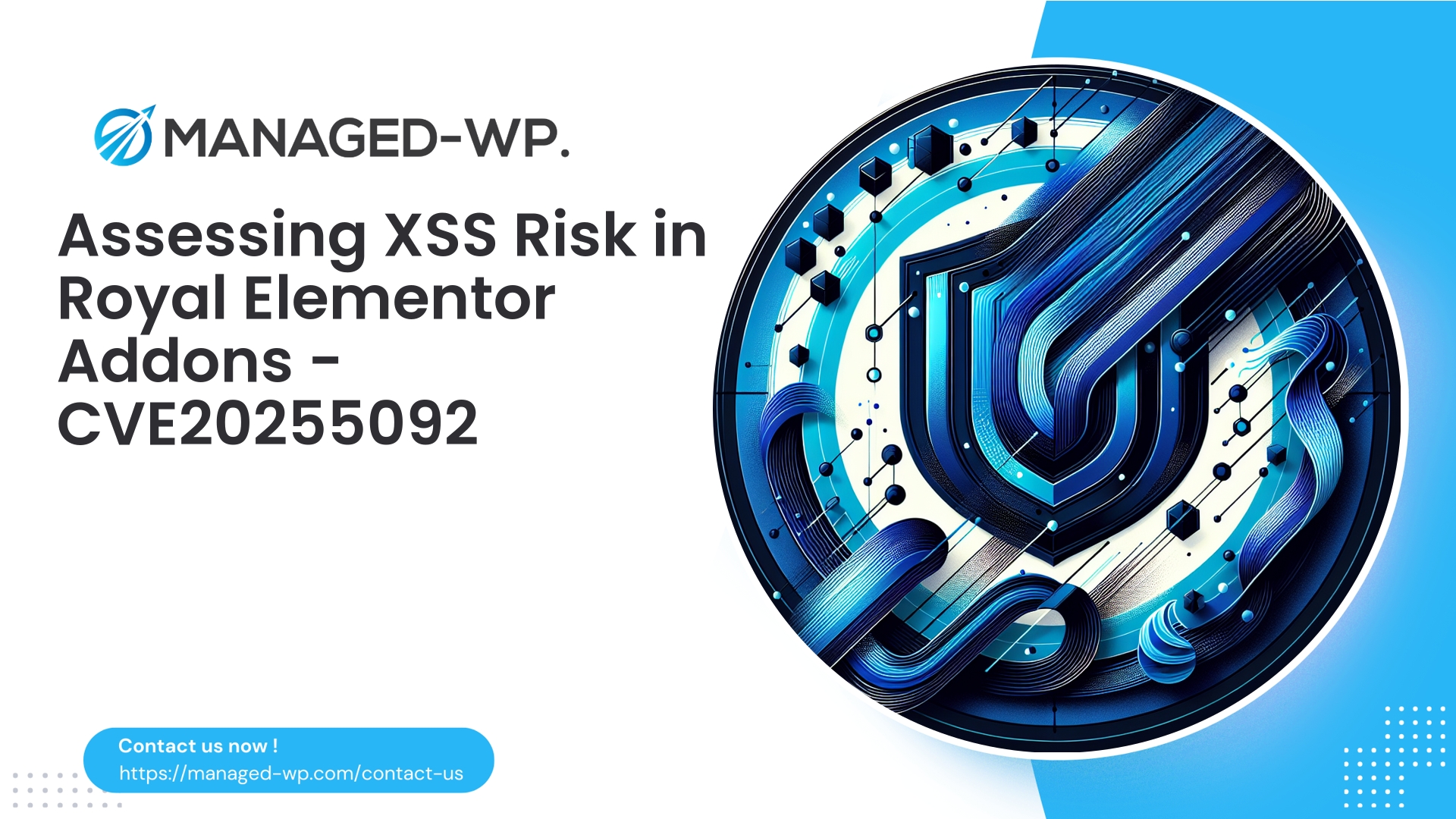| Plugin Name | Image Hover Effects Ultimate |
|---|---|
| Type of Vulnerability | Cross-Site Scripting (XSS) |
| CVE Number | CVE-2025-5092 |
| Urgency | Low |
| CVE Publish Date | 2025-11-20 |
| Source URL | CVE-2025-5092 |
Urgent Security Notice: Authenticated DOM-Based Stored XSS in Image Hover Effects Ultimate (≤ 9.10.5)
Executive Summary
- CVE Identifier: CVE-2025-5092
- Impacted Plugin: Image Hover Effects Ultimate — all versions up to and including 9.10.5
- Vulnerability Type: Authenticated (Contributor+) DOM-based Stored Cross-Site Scripting (XSS)
- Access Required: Contributor role or higher
- Public Disclosure Date: November 20, 2025
- Patch Availability: No official fix released as of this writing
- Managed-WP Severity: High priority mitigation strongly advised despite medium CVSS score
At Managed-WP, our security analysts bring years of hands-on experience responding to WordPress plugin vulnerabilities and deploying Web Application Firewall (WAF) protections. This advisory explains the Image Hover Effects Ultimate vulnerability, its attack mechanics, the practical risks to your site, how to identify whether you’re at risk or compromised, and critical mitigation approaches—both immediate and long-term. This guidance is intentionally clear and action-focused, crafted for site owners, administrators, and developers.
1) Understanding the Vulnerability
This vulnerability involves a DOM-based stored XSS flaw in versions ≤ 9.10.5 of the Image Hover Effects Ultimate plugin. The plugin saves user-submitted data — such as image titles, descriptions, and hover content — and injects it directly into the browser DOM when rendering galleries via a lightbox-style script. Unfortunately, this insertion happens without proper sanitization or escaping, allowing malicious JavaScript to persist and execute.
Key Points:
- It requires authenticated Contributor-level access or above, which some sites grant to non-admin users.
- The XSS is stored in plugin data, so malicious payloads persist and trigger when visitors view affected content.
- The attack executes client-side through the plugin’s JavaScript DOM insertion, facilitating a broad range of post exploitation actions.
- No official vendor patch has been released at disclosure time, placing extra importance on virtual patching or other mitigations.
2) Real-World Impact of This Vulnerability
An attacker exploiting this vulnerability can:
- Hijack user sessions by stealing authentication cookies or CSRF tokens.
- Alter website content by defacing pages or redirecting users to malicious domains.
- Distribute malware through injected JavaScript leading to drive-by downloads.
- Escalate privileges via cross-site request forgery combined with XSS.
- Damage your site’s reputation, including SEO penalties and loss of customer trust.
- Insert tracking or ad fraud scripts, compromising your supply chain integrity.
Since the payload is stored, the malicious code remains effective indefinitely until explicitly removed.
3) Attack Execution Flow
- A Contributor user submits crafted payloads in image hover text fields such as titles, descriptions, or captions.
- The malicious code is saved in the plugin database.
- When visitors access galleries or lightboxes, the plugin’s JavaScript appends stored HTML with embedded scripts directly into the DOM without filtering.
- The browser executes attacker-supplied scripts, enabling data theft and other attacks.
This vulnerability is classified as DOM-based because the script injection and execution occur client-side via JavaScript DOM manipulations—not purely through server-side output escaping failures.
4) Assessing Your Site’s Exposure and Signs of Compromise
Follow this checklist to evaluate your site:
- Verify if Image Hover Effects Ultimate is installed and check the version (≤ 9.10.5 vulnerable):
- WordPress Dashboard → Plugins → Locate “Image Hover Effects Ultimate”
- Confirm version number for vulnerability exposure
- Audit Contributor accounts:
- WordPress Dashboard → Users → Contributors
- Look for suspicious recently created or edited image hover entries
- Search your database for suspicious script tags or event-handler attributes in plugin content:
SELECT ID, post_title FROM wp_posts WHERE post_content LIKE '%<script%' OR post_content LIKE '%onerror=%' OR post_content LIKE '%onclick=%';
- Check front-end pages for injected script elements using browser developer tools.
- Monitor server logs for unusual outgoing HTTP requests or POST actions consistent with exploitation.
- Run comprehensive malware scanning tools focused on injected JavaScript in posts, meta, and uploads.
If you discover signs of exploitation or confirmed presence of the vulnerable plugin version, act quickly to mitigate risk.
5) Immediate Mitigation Measures
In absence of a vendor patch, prioritize these actions:
- Deactivate or remove the plugin temporarily until updates are available to halt exploitation vectors.
- Limit Contributor role capabilities by disabling new content creation or temporarily revoking privileges.
- Audit and clean existing image hover items, removing any suspicious HTML or scripts.
- Apply short-term sanitization filters to strip <script> tags and event handlers from contributor-submitted content.
- Implement a strict Content Security Policy (CSP) to deter inline-script execution where feasible.
- Deploy WAF or virtual patch rules to identify and block malicious requests targeting this vulnerability.
Note: Removing/deactivating the plugin is the most effective emergency step; if business needs require the plugin live, combine virtual patching and sanitization as a stop-gap.
6) Recommended Sanitization Snippet for Immediate Use
// managedwp-sanitize-contributor-input.php
add_filter('wp_insert_post_data', 'managedwp_sanitize_contributor_post_data', 10, 2);
function managedwp_sanitize_contributor_post_data($data, $postarr) {
$current_user = wp_get_current_user();
if ( ! empty($current_user->ID) && ! user_can($current_user, 'unfiltered_html') ) {
$allowed = wp_kses_allowed_html('post');
$data['post_content'] = wp_kses($data['post_content'], $allowed);
$data['post_content'] = preg_replace('/(]+?)\s+on\w+\s*=\s*(["\']).*?\2/si', '$1', $data['post_content']);
}
return $data;
}
Important Considerations:
- Use this code on a staging environment first and thoroughly test stability.
- This snippet is a temporary safeguard until an official patch can be applied.
7) WAF and Virtual Patching Guidance
A Web Application Firewall can block exploitation attempts by inspecting HTTP requests for malicious payloads targeting this vulnerability. A conceptual example rule logic includes:
- Blocking POST requests to plugin and admin AJAX endpoints that contain:
- <script> tags in form fields
- Event-handler attributes (e.g., onclick=, onerror=)
- Suspicious attributes such as data-sub-html= or data-html= with embedded < characters
SecRule REQUEST_URI "@rx (admin-ajax\.php|wp-admin/admin-ajax\.php|image-hover-effects-ultimate)" \
"phase:2,deny,log,status:403,id:123456, \
msg:'Block XSS injection attempt in Image Hover Effects Ultimate', \
chain"
SecRule ARGS|ARGS_NAMES|XML:/*|REQUEST_BODY "@rx (<script|onerror=|onclick=|data-sub-html=.*<)" \
"t:none,t:urlDecode,t:lowercase"
Managed-WP offers tailored virtual patching via our managed WAF, providing immediate protection even before vendor fixes are released.
8) Long-Term Security Best Practices
- Apply least privilege—assign Contributor or higher roles judiciously with strict workflows.
- Strictly sanitize and escape all user input and dynamic content both server- and client-side.
- Limit raw HTML in user-submitted fields; use whitelisting and restrict event handlers.
- Set strong cookie flags (HttpOnly, Secure, SameSite) to reduce XSS impact.
- Use Content Security Policy headers to block unsafe scripts and inline code.
- Stay current with plugin/theme updates and advisories, applying patches promptly.
- Leverage a WAF with virtual patching capability to mitigate zero-day risks.
- Conduct regular scans and security audits to detect infections early.
9) Steps if You Suspect Exploitation
- Put the site into maintenance mode to prevent additional visitor exposure.
- Create a full backup of files and databases to preserve forensic evidence.
- Rotate all admin/editor passwords and any exposed API or SSH keys.
- Immediately remove or deactivate the vulnerable plugin.
- Clean up injected malicious content (posts, meta, uploads).
- If cleanup isn’t feasible, restore from a known-good backup.
- Run comprehensive malware and integrity scans.
- Analyze server logs to understand intrusion vectors and timelines.
- Reinstall WordPress core, themes, and plugins from trusted sources.
- Monitor the site closely post-remediation for suspicious activity.
If your website supports critical business functions and the compromise appears complex, consider engaging an experienced incident response partner immediately.
10) Developer Recommendations
- Never rely solely on client-side sanitization; implement server-side validation and escaping.
- Sanitize outputs contextually using functions like
esc_html(),esc_attr(), andwp_kses(). - Avoid directly injecting raw HTML strings into the DOM using
innerHTML; prefer safe DOM APIs. - Whitelist permitted HTML tags and attributes explicitly, and disallow all event handler attributes in user-generated content.
- Regularly update third-party libraries and monitor their security advisories.
- Establish a rapid-response process for security issues, including virtual patching workflows.
11) How Managed-WP Shields Your Site
Managed-WP provides comprehensive defenses against vulnerabilities like this:
- Managed WAF: Our firewall delivers immediate virtual patches to block attempts to exploit plugin vulnerabilities at the HTTP layer.
- Malware Detection: Continuous scanning of posts, metadata, uploads, and themes for injected malicious code.
- OWASP Top 10 Coverage: Focused rules tuned to detect and block prevalent XSS attack patterns, including DOM-based variants.
- Automatic Threat Mitigation: Blocking, throttling, and IP blacklisting reduce your exposure to repeat attackers.
- Expert Incident Support: Guidance and remediation help minimize downtime and data loss.
When patches aren’t available, Managed-WP’s virtual patching is your fastest line of defense.
12) Quick Detection Checklist for Site Admins
- ☐ Verify if “Image Hover Effects Ultimate” is installed and version ≤ 9.10.5.
- ☐ Temporarily deactivate the plugin, if possible.
- ☐ Audit Contributor accounts for unexpected additions or modifications.
- ☐ Search your database for
<script,onerror=,onclick=,data-sub-html=or similarly suspicious tags. - ☐ Run a full malware scan on your site.
- ☐ If the plugin must remain active, enforce strict CSP headers and deploy a tailored WAF rule.
- ☐ Backup your site and remove suspicious content promptly.
- ☐ Rotate all administrator credentials and API keys.
13) Example Content Security Policy (CSP) Header
Add this header on your web server or via an HTTP header plugin (test carefully to avoid breaking site functionality):
Content-Security-Policy: default-src 'self'; script-src 'self' https://trusted-cdn.example.com; object-src 'none'; base-uri 'self'; frame-ancestors 'self'; form-action 'self'Recommendations:
- Avoid using
'unsafe-inline'; prefer hash or nonce-based script allowances. - Implement gradually, testing on a staging site before broad deployment.
14) What to Demand From the Plugin Developer
- Publish a detailed security advisory with vulnerability context and affected data fields.
- Release a concrete patch with visible changelog entries highlighting security fixes.
- Disseminate mitigation instructions for site owners unable to update promptly.
- Offer back-ported fixes or a clear timeline for safe plugin updates.
If vendor responsiveness lags, virtual patching solutions must fill the protective gap.
15) Strengthen Your Protection Today — Free Managed WAF & Malware Scanning
For immediate, hands-off defense while you assess and remediate plugin vulnerabilities like this, Managed-WP offers a free Basic plan that includes comprehensive Web Application Firewall protections, unlimited bandwidth, and malware scanning tailored to block OWASP Top 10 risks including stored and DOM-based XSS attacks.
Sign up now to get an essential security layer active while you prepare permanent fixes: https://managed-wp.com/pricing
16) Summary & Next Steps
- If running “Image Hover Effects Ultimate” ≤ 9.10.5, treat this as an emergency vulnerability.
- Deactivate the plugin and purge any suspicious content immediately.
- If the plugin must stay active, deploy short-term sanitization, strict CSP, and WAF rules without delay.
- Audit contributor accounts, rotate credentials, and monitor for suspicious activity.
- Use Managed-WP services for rapid virtual patching and proactive malware scanning until vendor patches become available.
Managed-WP experts can also:
- Create bespoke WAF rules tailored for your hosting environment.
- Generate site-specific sanitization plugins that can be removed once official fixes are applied.
- Assist with safe detection scripts and SQL audits for vulnerability assessments.
Your site’s security depends on swift action. Virtual patches combined with conservative access controls buy critical time to apply permanent fixes without risking visitor or administrator safety.
Take Proactive Action — Secure Your Site with Managed-WP
Don’t risk your business or reputation due to overlooked plugin flaws or weak permissions. Managed-WP provides robust Web Application Firewall (WAF) protection, tailored vulnerability response, and hands-on remediation for WordPress security that goes far beyond standard hosting services.
Exclusive Offer for Blog Readers: Access our MWPv1r1 protection plan—industry-grade security starting from just USD20/month.
- Automated virtual patching and advanced role-based traffic filtering
- Personalized onboarding and step-by-step site security checklist
- Real-time monitoring, incident alerts, and priority remediation support
- Actionable best-practice guides for secrets management and role hardening
Get Started Easily — Secure Your Site for USD20/month:
Protect My Site with Managed-WP MWPv1r1 Plan
Why trust Managed-WP?
- Immediate coverage against newly discovered plugin and theme vulnerabilities
- Custom WAF rules and instant virtual patching for high-risk scenarios
- Concierge onboarding, expert remediation, and best-practice advice whenever you need it
Don’t wait for the next security breach. Safeguard your WordPress site and reputation with Managed-WP—the choice for businesses serious about security.
Click here to start your protection today (MWPv1r1 plan, USD20/month).



















